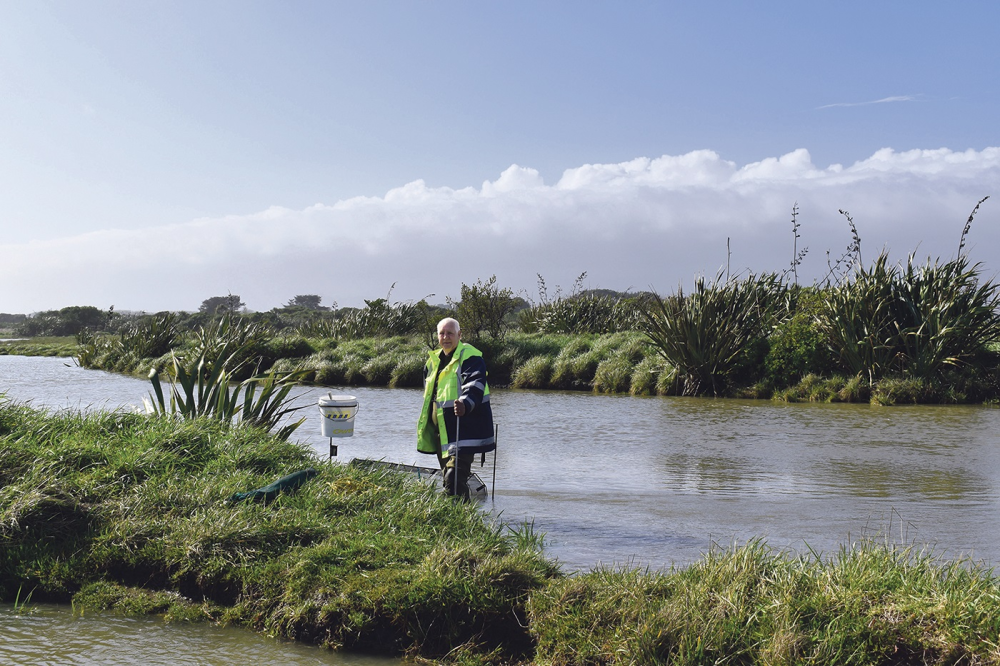
Continued dumping of rubbish along Ōtaki’s waterways and estuaries is threatening the biodiversity of the area’s fragile ecosystem, just as whitebait season starts.
The rubbish includes industrial waste, concrete and construction rubble, tyres, clothing and green waste – grass clippings among them.
In Ōtaki, Greater Wellington has issued formal warning letters to individuals suspected of dumping rubbish in the KNE, for which fines of up to $20,000 can be imposed. Two warning letters have been issued in Ōtaki so far in 2024.

Trevor Howell checks his whitebait net at the Ōtaki River estuary on day one of the 2024 whitebait season. The estuary is part of the Ōtaki Coast Key Native Ecosytem, vulnerable to illegal dumping of waste.
Photo Ōtaki Today
A commercial lawn-mowing operator allegedly dumping green waste was also charged with assault by police earlier this year after he was confronted by a member of the public.
The Ōtaki River estuary is a particular target due to its accessibility. Officially it is the Ōtaki Coast Key Native Ecosystem (KNE), a dynamic and rare grouping of coastal and wetland habitats under the care of Greater Wellington Regional Council and volunteer groups.
Greater Wellington acknowledges the problem, although the extent of “fly tipping” in the estuary is not as serious as that on Te Awa Kairangi/Hutt River – only by virtue of Ōtaki’s lower population.
However, the frequent and illegal dumping of rubbish in the estuary threatens the significant indigenous biodiversity of a fragile ecosystem, including the whitebait that arrive at this time of the year.
“Green waste is often dumped in this KNE, hidden among large flaxes by locals without respect for this precious taonga on their doorstep, or those working to protect it,” a council spokesperson told Ōtaki Today. “Dumping green waste can lead to the introduction of harmful weed species to the KNE.”
When green waste is found, it’s retrieved and taken to the landfill at the council’s (ratepayer) expense.
Dumping of green waste can harm the KNE because of its potential to introduce noxious weeds, such as tradescantia and montbretia. If they’re part of grass clippings, they spread quickly, impeding the seedlings of native species from establishing. Tradescantia mats on riverbanks can break away and contribute to flooding. The weed also causes severe dermatitis in dogs and other animals.
Tyres recently dumped by the estuary were a particularly galling discovery for regional council staff, who were able to identify and officially warn the alleged perpetrator.
“Tyre dumping is a region-wide problem. The council bears significant costs to safely recycle retrieved tyres,” the spokesperson said.
“Sadly, fly-tipping occurs regularly throughout Kāpiti. We were recently disappointed to find four car doors dumped on the margins of the Waikanae River by the carpark off State Highway 59, a popular recreation area regularly targeted for illegal dumping.”
The public is urged not to confront or antagonise people dumping rubbish, but to discreetly take photos and note licence plates if it can be done safely. Greater Wellington says it will always protect privacy with any information supplied.
Anyone seeing rubbish being dumped in the KNE can call Greater Wellington’s environmental hotline: 0800 496 734.
OTHER STORIES
LATEST POSTS
- Concerts line up for rotunda
- No respite for ‘cone town’
- Petition spurred by road works disruption
- Heniti vows to put Ōtaki first
- Trout spawn in Winstone Lakes
- Rāhui Rd next in line for road works
- ‘Monkey’ back to old tricks
- Plenty of choice in election race
- Ōtaki dominates awards night
- Sam risks all for Gaza
- Four now vie for Ōtaki Ward
- Heniti ‘proud to call Ōtaki home’
- Infrastructure works keep rolling on
- An ONZM for arts, sport, heritage
- Trappers aim for predator free Te Horo
- ‘No Ōtaki consultation’ on polyclinic
- Te Horo hall wants land for car park
- Beach burglars pinch trailer and tools
- Rob throws hat in ring for Ōtaki Ward
- Toilet vandalism ‘tragic, sad’
- Fifty years for Ōtaki fire chief
- Idiots in cars’ block highway
- Oiroa Kaihau – a focused career soldier
- ‘Aunty Gabe’ Rikihana gone at 98
- Vote stands as council reconsiders Moy decision
- Te Horo Hall opens for ‘future generations’
- Demographic shift offers ‘new opportunities’
- Kite magic returns to Ōtaki skies
- Crowds out for Waitangi Day
- Marian retires from women’s club
- Moy developers seek judicial review
- Charlie beats the odds
- Rescuers seek funds
- Ōtaki Rotary winds up after 60 years
- Czech president visits Te Horo kilns
- Moy-Sue residents celebrate council vote
- Waitohu students get peek at reservoir
- Kids get koha for good
- Waikawa residents petition to save footbridge
- Cr’s fireworks spark neighbourhood ire
- Bert celebrates 100th birthday
- Residents ‘corralled’ at council meeting
- Aunty Hira gone, aged 92
- New GP service on the way
- A touch of class in beach bus
- Te Horo bus stop sites confirmed
- Terama rides for charity
- Whitebait season gets under way
- Eric’s innings falls just short of century
- New Te Horo wetland taking shape


